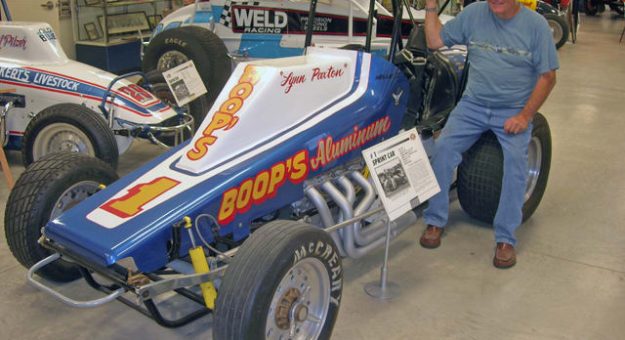“They were making the bodies smaller and smaller,” Paxton recalled, “and finally it got to where the bodies were hard to come by, so they decided in the end that you really didn’t need a body, just a frame that had a 90-inch wheelbase and a roll cage that was 30 inches wide. That was your supermodified, your 30-by-90 car. They were very competitive cars and there were a lot of them, but Jack Gunn started the National Open and it was run what you brung. A lot of the guys that came in from out of town were running sprint cars and they kicked our rear ends.”
The evolution continued as Paxton switched to Shorty Emrich’s team, running a Kenny Weld chassis with Chevrolet power. By the end of 1969, Paxton was in a proper sprint car, built by Ohio’s Floyd Trevis. Furthering the transformation, Emrich hired Miamian Bobby Allen, the guy who gets a lot of credit for inventing the modern tube-chassis, drag-rubber sprint car, as Paxton’s teammate. By 1972, Paxton had won three track titles.
After a stint with Al Hamilton, Paxton was briefly an owner-driver before connecting with car owner Maynard Boop, leading to the most prolific winning period of Paxton’s career. No discussion about these years would be complete without mentioning another Pennsylvania innovation, the sprint car powered by an aluminum big-block engine that provided the torque that was just the ticket to getting around Williams Grove Speedway.
“We were the first ones to do that,” he said. “Billy Gettle was my engine man and he found one of the Chevrolet ZL1 blocks. They only built about 180 of those aluminum big blocks. Billy got me one and we went really good with it. It had a ton of horsepower. Then later, Don Yenko bought the rights to the ZL1 block from General Motors, and because we were winning, he asked me to run his blocks, which I did, until he was killed in a plane crash in 1983.
“I won the National Open in 1982 in a Lloyd car, then again in 1983 in a Gambler with a Yenko big block,” Paxton continued. “You either build a low-rail car, before the downtube cars, or else kick the rail out a couple of inches for the engine to fit. When I won in 1983, Davey Brown Sr. built the motor, about 480 cubic inches. To get over 500 inches, you had to go to one of the Rodeck blocks with a taller deck.”
The big blocks lasted until the central Pennsylvania tracks aligned their rules with the World of Outlaws later in the 1980s. Led by Williams Grove, the state became a magnet for national touring pros, which added another dimension to Paxton’s résumé. Paxton trailered the likes of Steve Kinser, Sammy Swindell and Doug Wolfgang, but when you ask him to name his mentors, his inspirations, he drifts farther back in history: Dick Tobias, Bobbie Adamson and Ray Tilley.
“It allowed me to find out where I wasn’t good enough or my equipment wasn’t good enough and every time I came back, I tried to get better,” he said. “My father supported me until I got going good. So did Harold Hank. Mr. Emrich was very good to me, and so was Bobby Allen. Billy Gettle built my engines for close to 50 years. And nobody’s won more races as a mechanic than Davey Brown. I was lucky to be around a lot of really good people.
“You look at a guy like Ray Tilley, a tremendous race car driver until he got hurt bad. But the five or six years that he and Bud Grim were together before that, they just rewrote the record book in central Pennsylvania,” Paxton said. “If he, Bobby Hersh and Gene Goodling hadn’t have gotten hurt back in the 1960s, there would have been a lot fewer wins for Lynn Paxton in Pennsylvania.”
Having been exposed to car restoration as a child, and being a history buff, Paxton’s second act has been to embrace them, racing and otherwise. He still has the 1934 Ford he drove to high school among his collectibles. Also in that mix is a 1953 Dodge truck that he uses to tow the Miracle Power sprint car that Hinnershitz raced, which he restored, and which is now in the Speedway Motors Museum of American Speed in Lincoln, Nebraska.
“At one time, it was all old wire-wheel, rail-frame cars, but lately it’s been more of the tube-frame cars, with or without a cage. I was the last guy to run the Meskowski car that Foyt won his first race in, so I restored that,” Paxton said. “Then Vic Yerardi bought the other Meskowski car that Foyt ran up to 1967 or 1968. I’ve probably done 15 to 20 cars but I don’t hear or see so good anymore, so I’m not doing any complete cars anymore. I’ve got way too many toys.”
